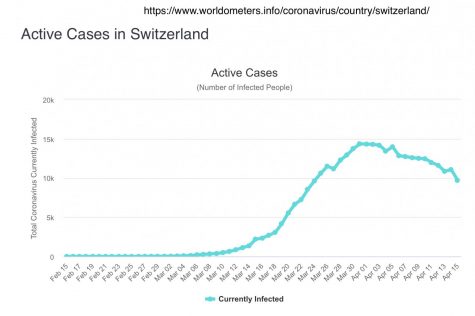Coronavirus around the world
April 17, 2020
Coronavirus around the world
As we all know, coronavirus is affecting many countries across the world. In some countries the number of cases is going down, in others it is still rising. Here‘s what quarantine looks like in different countries around the world:
Switzerland
Switzerland’s active coronavirus cases are currently decreasing and more than 15,900 patients have already recovered. Eliane Ficht and Vincent Lienert are two Swiss students. Vincent says he’s just taking it day by day and sleeps in every day till about 10-12am. To keep busy he likes doing TikToks and watching Netflix. Eliane doesn’t feel like online learning is much different from what she’s used to, “we work a lot on computers in school too”. According to the Swiss government the peak of cases was already reached, “fortunately, the hospitals were never overloaded and the government wants to open everything step by step starting next month,” says Eliane. She still finds a lot of things to do during quarantine. “There are a lot of lakes and mountains, so we can still go outside hiking, biking and that stuff. [On] a hot day I can go help the farmers. Netflix is also a great friend right now. And if there is really nothing to do I can still annoy my siblings.” All stores, except grocery stores are currently closed in Switzerland, “trains and buses drive less often, most people work from home, big events like festivals and even church services don’t take place. Sport seasons have been postponed to later [and] you are not allowed to be in a group that has more than 5 people and [have to] keep 2 meter distance.”
Liechtenstein
Isabelle Zäch and Bruna Ospelt are two students who live in Liechtenstein, a country located between Austria and Switzerland. They are currently in quarantine, like many corona affected countries. Now students that don’t generally do school work online have to start using technology for learning purposes. Bruna, who attends a school in Austria, now studies at home using Microsoft Teams. She says that she likes learning like this a lot, “its not as stressful as in school”. “But I also miss my scheduled everyday life at school and of course meeting my friends,” she adds. Both Isabelle and Bruna are not scared but rather have respect towards this virus. They say they wouldn’t want people at risk to come in contact with the virus. While Isabelle says that she usually follows a daily routine of doing her school work starting at about 8 am, and follows a schedule similar to what school would normally be like, Bruna doesn’t have a routine whatsoever. She wakes up at 9:30am or 10am and plans her day “according to [her] mood most of the time”. Isabelle says that her classes rarely have video calls, and class work is very different for each class. “Some teachers give assignments for only one day, some for one week and other teachers for the whole time. It’s a bit different in every subject”, says Isabelle. She adds that “the cases are decreasing at the moment, we have [very few] active cases. Our head of government told us that we are at the end of stage 1”. They still have restrictions, but Bruna says that in her opinion the restrictions aren’t very harsh, “we are allowed to go out but not with more than 5 people, the grocery stores are counting how many people [enter the store], but the government says that you only should leave your house for work, or to run errands but its not forbidden [to] go outside.”
Denmark
Karoline Fischer was a Exchange Student at Flower Mound High School this year, who had to return to Denmark due to the virus. She says that she was very upset when she found out that she had to leave the U.S. “I was so ready for the last 2 months,” she says, “at the same time I also totally understood the choice my organization had to take and I understand that it’s probably better to be with my real family in this time of crisis.” She also knows that she can always come back to visit after the pandemic is over. People are still social distancing, and the cases in Denmark are still increasing, but the rate is slowing down. The government is starting to slowly reopen. “Kids from 3 – 12 years are back in school so that parents can work. Things like hair dressers and physiotherapy are reopening from Monday.” Since Karoline was supposed to finish her school year in the US she currently isn’t enrolled in school in Denmark, “with the school system in Denmark, this year that I’m doing right now is actually an optional year”. This means that she doesn’t have to go to school until the start of next school year. She’s very bored, because she doesn’t have anything to do, “I started working out almost everyday to make the time go [by] something and then right now my mom has a sprained foot, so I’m helping with laundry, making dinner and lots of other chores. I’m also walking, sometimes with a friend (walking with distance, haha) and sometimes with my dog.” She doesn’t have a routine and just takes it day by day. “I usually wake up between 9am – 11am. I know I should probably wake up earlier, but it’s hard when I know I literally have nothing to do all day”.

